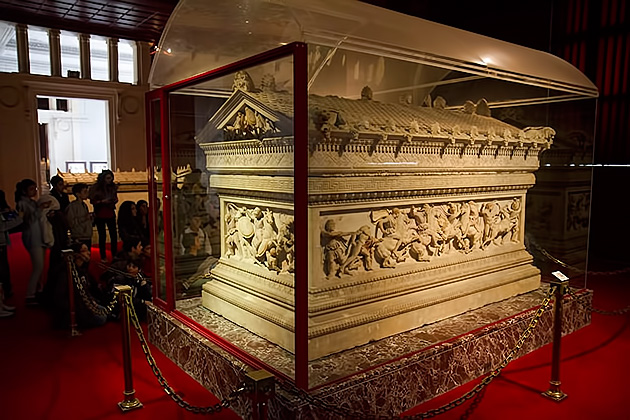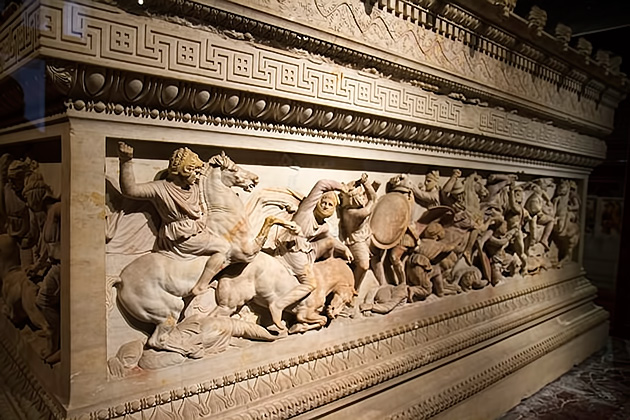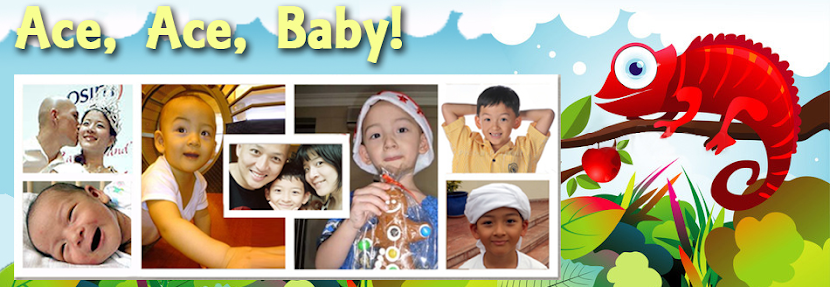Set at the outskirts of the Topkapi Palace, the museums contain lots of interesting things.
Apparently, in the olden days, they actually had a law where anyone who found something will send it to the museum and so they really have quite a large collection of things...
What is more, Turkey itself has such a rich history, so you can really see alot of different things in these museums..
Too bad though, we only went to two museums and missed out on the museum where they display Islamic Art... Also, by then we were trying to finish everything and return back to our hotel... so we really just zou ma kan hua... And now that I am surfing the web for more info, I actually think would really enjoy the Museum of Islamic Art. Must go again when I have a chance to visit Istanbul again:)
First we visited the Museum of Ancient Orient and it has many exhibits from long long long long time ago... hahaha...
These artifacts look kind of egyptian.. that is cos they are!:) wahahah
I thought this is some sort of replica but apparently it is a real find from an ancient egyptian tomb!
In the Ancient Egypt, it was believed that the soul was returning, after leaving the body with death. Since the belief in afterlife was very widespread and deep-rooted, tomb finds constitute a large part of Egyptian artifacts that reached today. It was believed that afterlife could only be normal in case of the existence of the body. Therefore, depending on their social positions, Egyptians were buried in monumental tombs such as pyramids, mastabas and rock-cut tombs or in ordinary graves dug into sand.

In the monumental tombs, the mummy was placed into two or three nested sarcophagi. The wooden, anthropoid sarcophagi were found during excavations at Deir el-Bahri, the burial place of the city Thebes. They belong to the priests and priestesses of the temple of God Amun, the Lord of Thebes. Inner and outer surfaces of the sarcophagi were plastered with thin layers of gypsum and they were ornamented with religious texts, charmed symbols that would protect the dead in the afterlife and mythological scenes. In a sarcophagus displayed uncovered, the mummies of Bak-Na-Mut and his cat next to his feet are seen. The internal organs extracted before mummification were mummified and placed into canopic jars. The lids of these jars were the heads of the four gods guarding dead persons. The stomach was stored in the jar of falcon-headed Imseti, the lungs in the jar of baboon-headed Hapi and the liver in the jar of falcon-headed Horus.
Sometimes, the mummy was covered with bead nets, wooden pillows were placed under its head and bead baskets made of straw were placed into the tomb chamber.
The Ishtar Gate (Arabic: بوابة عشتار) was the eighth gate to the inner city of Babylon. It was constructed in about 575 BC by order of King Nebuchadnezzar II on the north side of the city. Parts of the gate and lions from the Processional Way are in various other museums around the world. The Istanbul Archaeology Museum has lions, dragons, and bulls. The above is the LION...
Actually to be honest, I did not have time to read about this gate and I just took a picture of it because I thought it looked beautiful:) wahaha.. they are glazed tiles with paintings on them...
Stoneware used by the people of long ago...
Only parts of the relics are found..
I took a picture of this statue because I find it very interesting. It looked as if the head is not part of the body but yet it fits so perfectly.
These are parts of some old walls from somewhere.. dun ask me where.. I zou ma kan hua.. din have time to read.. I just find that they are beautiful and took pictures of them:)
That is how it looked like originally..
Ancient jewellery, anyone?
I think this is an obelisk of some sort..
THat's it.. we are done!:) And out we go..
As we walked to the main building of Archeology Museum of Istanbul, along the way, there are alot of relics just left around ... I dunno if it is because there is no place to store them or they are just left there as an exhibit..
Again, we noticed the statue has no head!
THat is the Museum of Islamic Art.... so sad we din get to visit..
This is the main building of the archeology museum..
There are many interesting things inside..
The Alexander Sarcophagus is a late 4th century BC Hellenistic stone sarcophagus adorned with bas-relief carvings of Alexander the Great.[1] The work is remarkably well preserved and has been celebrated for its high aesthetic achievement. It is considered the outstanding holding of the Istanbul Archaeology Museum.

FYI, a sarcophagus A sarcophagus (plural, sarcophagi) is a box-like funeral receptacle for a corpse, most commonly carved in stone, and displayed above ground, though it may also be buried.

Another famous Sarcophagus isSarcophagus of the Crying Women also found here.

In the Sarcophagus of the Crying Women, found at the Royal Necropolis in Sidon like the Alexander Sarcophagus, nothing could be found other than the bones of its owner and a bronze belt buckle, since it had been robbed in an earlier time. From the partial traces on the marble that remained until today, it is understood that it had been dyed in blue and red initially. It is the best example of the group called by archaeologists "Sarcophagi with Columns", and it is considered as a final resting place, like the "Mausoleum of Halicarnassus" or the "Nereid Monument", rather than a tomb. Its architectural features were used in the architecture of the old building of the İstanbul Archaeological Museums. It is an example of the Greek sculpture displaying Eastern influences. The shaved heads, bear feet, ragged clothes of the figures and their movements and expressions of sadness are features of Semitic societies. It is thought to be the sarcophagus of the King of Sidon, Straton (374-358 BC), who was said to have led a life of pleasure. The sarcophagus has the shape of an Ionian temple.
It is thought that the figures of 18 sad women between the columns represent the wives of the dead person or the women in his seraglio, rather than crying women who were common in the Middle Eastern countries.
All pre-Greek people of Anatolia built beautiful monumental tombs associated with some form of ancestor worship. This is the so-called "Lycian Sarcophagus" from the Royal Necropolis of Sidon (in modern Lebanon). The necropolis, belonging to line of Phoenician kings from middle of the fifth century BCE to the latter fourth century BCE, was discovered in 1887 by a Lebanese villager who was digging a well.
Although from Sidon, this sarcophagus resembles the Lycian sarcophagi (hence the name) which can be found in Anatolia. This side of the sarcophagus depicts five mounted hunters in Thracian attire.
I think... these bones are a replica.. but still gives me chills...
A sarcophagus (plural, sarcophagi) is a box-like funeral receptacle for a corpse, most commonly carved in stone, and displayed above ground, though it may also be buried.
These here are the Sarcophagi of Tabnit... they were the earliest Sarcophagi found...

This is how the statue above is supposed to look like. This one is called the Standing Youth.
A peek at life in the past..
There was a series of greek-like statues..
Guess who this is?
This is Alexander The Great!:)
This card tells you what the statue above is about... I dunno why they want to make a statue of a person tat was being punished.....
The Statue of Marsyas, dated to the Hellenistic period, was found in Tarsus, a historical city in south-central Turkey.
He is depicted as hung from a tree and his muscles stretched due to torture draw attention. So to say, he has a physically silent but angry expression. The original version of this special statue should have been placed to the center of a group of statues including the statue of Apollo sitting on his left side and a slave sharpening his knife in order to skin him on his right side.
Marsyas, the main character of an Anatolian story, is depicted while bearing the consequences of his rivalry with Apollo, the god of music. According to the story, Marsyas claims that he plays his flute better than Apollo plays his lyre. Neither of them wins in a musical contest, but Apollo asks Marsyas to turn his instrument upside down and to add his own voice. However, Marsyas cannot meet this challenge and Apollo wins the contest. Angry because of being challenged by a mortal, Apollo skins Marsyas alive and hangs his skin to a pine tree. However, he feels sorry later, breaks his lyre and turns Marsyas into a river.
These is some greek poetess or something..
Ace asked me why all these statues never wear clothes.. wahahaha..I din now how to answer him then... but the other day, we were talking about GREEK stuff and Athens and Ace was telling me that the year 5 and 6 people are learning about the Greeks. And because the Greek's clothes were very heavy, they were usually naked when they were doing sports... even the women!
He said the ipads in school are passed around and so when it was passed to him, the remenants of the year 6 research is still there and that was how he found out...
Then, there was this section about the history of Istanbul...
This poster talks about how old Istanbul was defined by some city walls. However, these walls can no longer be seen anymore...
Old earthenware used in olden times... To me it is a miracle how they pieced everything back together!
Here are some of the legends related to the founding of Istanbul... If you are interested in the historical facts, click here to read..
Anyway, Apparently, since Neolithic times, people have lived in this area now known as Istanbul.
The earliest known settlement dates from 6700 BC and the first human settlement on the Anatolian side (that refers to the Asian Side of Istanbul), the Fikirtepe mound, is from the Copper Age period, with artifacts dating from 5500 to 3500 BC.
In 685BC, some greek settlers from Megara chose to colonize it. Eventually it became known as Byzantium. And eventually, when the ancient Romans took over Greece, they took over this place as well.
In fact, the place where the famous Topkapı Palace now stand is where the famous Acropolis used to stand. They eventually even made Istanbul one of the Roman Capitals...
So leh, there were alot of greek and roman things found in Turkey itself...
Ace was very tickled by this "BUM"
And I think it gives and insight to life then...
If I am not wrong, these are decorations they put in cemetries..
This one is decoration of a tombstone of a couple who were buried together...
More about the Hippodrome...
Some earthenware they used to use...
And even jewellery!
One of the recovered mosaics... notice how even though the picture seems christian in nature, the surrounding frame design is very typical Turkish pattern sort of design?
And then there is the CHAIN OF THE GOLDEN HORN.
The Golden Horn (Turkish: Haliç), or Altın Boynuz (literally, "Golden Horn"); is a major urban waterway and the primary inlet of the Bosphorus in Istanbul, Turkey. It is a horn-shaped estuary (hence, the name) that joins Bosphorus Strait at the immediate point where said strait meets the Sea of Marmara, thus forming a narrow, isolated peninsula, the tip of which is "Old Istanbul" (ancient Byzantion and Constantinople), and the promontory of Sarayburnu, or Seraglio Point. The Golden Horn geographically separates the historic center of Istanbul from the rest of the city, and forms a natural, sheltered harbor that has historically protected Greek, Roman, Byzantine, Ottoman and other maritime trade ships for thousands of years.
While the reference to a "horn" is understood to refer to the inlet's general shape, the significance of the designation "golden" is more obscure, with historians believing it to refer to either the riches brought into the city through the bustling historic harbor located at the Golden Horn, or to romantic historic interpretations of the rich yellow light blazing upon the estuary's waters as the sun sets over the city. Its Greek and English names mean the same, while its Turkish name Haliç, simply means "estuary", and is derived from the Arabic word khaleej, meaning "gulf".
Throughout its storied past, the Golden Horn has witnessed many tumultuous historical incidents, and its dramatic vistas have been the subject of countless works of art.
The Golden Horn (Keras) forms a deep natural harbor for the peninsula it encloses together with the Sea of Marmara. The Byzantine Empire had its naval headquarters there, and walls were built along the shoreline to protect the city of Constantinople from naval attacks. At the entrance to the Horn on the northern side, a large chain was pulled across from Constantinople to the old Tower of Galata to prevent unwanted ships from entering.
According to a tour guide I overheard, This museum only keeps part of this Chain of the Golden horn while the rest of it is elsewhere all over Turkey.
Then it was time to go.. last few shot...
Goodbye Istanbul... I am going to miss you....
Previous Post: Istanbul Trip Part 16: Museum of The History of S...


























































































No comments:
Post a Comment